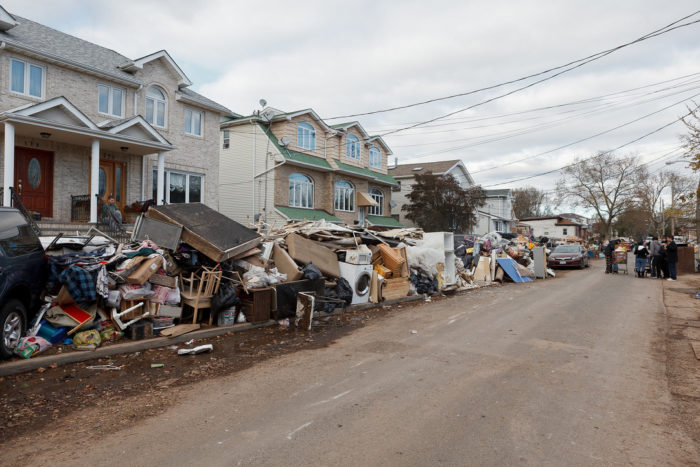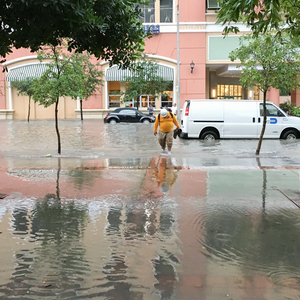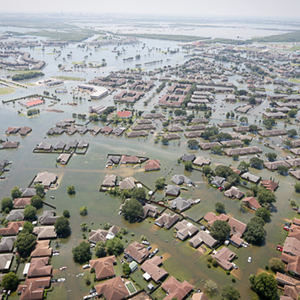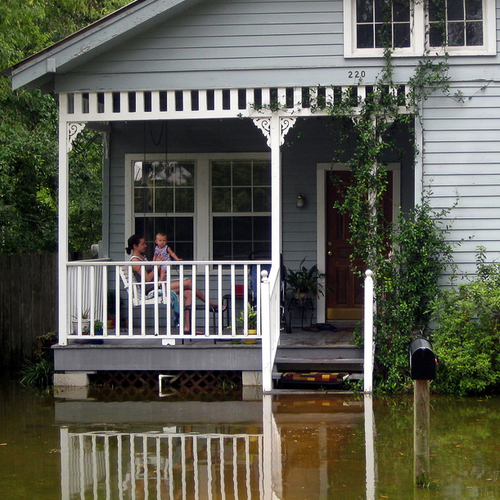
Image Credit: John de Guzman / CC BY-ND 2.0 / Flickr
The Natural Resources Defense Council has released a groundbreaking report, Seeking Higher Ground, that takes a hard look at the plight of people whose homes are repeatedly flooded and the difficulties they face in acquiring assistance to move somewhere safer.
Under the National Flood Insurance Program (NFIP), a federal disaster aid program administered by the Federal Emergency Management Agency (FEMA), some of the most flood-prone properties in the country have been repeatedly rebuilt even when it would be less expensive to help homeowners move to higher ground. NRDC has proposed an innovative program that would guarantee a homeowner a buyout of their flood-prone home, enabling them to move to a safer location in the aftermath of a flood.
Since 1978, more than 30,000 properties have been flooded so often they’ve been designated “severe repetitive loss properties” (SRLPs) under the NFIP. That’s not a designation any homeowner wants. On average, these properties flooded five times every 2 to 3 years. Some of the most affected properties have flooded more than 30 times. In each case and after every flood, the NFIP paid to rebuild the property at a cost of $5.5 billion.
Today there are thousands of these properties. In the coming decades, our analysis indicates there will be millions of these properties as a result of sea level rise and the impacts of climate change.
Little spent to move people to safety
FEMA’s current approach to address the problem of homes that are repeatedly flooded is to ensure the owners have coverage under the NFIP and then rebuild their properties — over and over again. While FEMA provides assistance to reduce the risk of flooding, these programs can take years to provide assistance to homeowners. Moreover, they have been woefully underfunded by Congress. For every $100 the nation has spent to rebuild homes through the NFIP, we’ve spent a paltry $1.72 to help people move out of harm’s way.
While many of these homeowners would like to move out of harm’s way, they find it extremely difficult, if not impossible, to get assistance to do just that. One such person is Olga McKissic, who owns a home in Louisville, Kentucky that’s flooded four times. Play the short video below to hear Olga’s story.
Since she was last flooded in April 2015, she has been trying to secure assistance from FEMA to buy out her home. Sadly, she has been told by local officials that it could take years before that happens, if it happens at all. In the meantime, Olga must hope that her home doesn’t flood again.
“It’s a nightmare to live here with the thought and the anticipation that it is going to flood again,” Olga says. “I don’t want other people to have to go through this.” Sadly, more and more people across the country are finding themselves in Olga’s situation.
The number of people in the same situation as Olga is growing ten times faster than the number of people who receive mitigation assistance and are already repeatedly flooding. With sea level rise, we could have millions of these properties in the coming decades.
We need a new mindset
NRDC’s analysis of this problem shows just how much we need to change our approach. We need to switch from a mindset of “flood, rebuild, repeat,” to one in which we offer homeowners timely assistance to move out of harm’s way.
Among our key findings:
(1) Since 1978 there have been more than 30,000 SRLPs. These properties represent 0.6% of all NFIP policies (5.1 million policies), but a disproportionate 9.6% of all flood damages ($57 billion since 1978).
(2) The homes of low and moderate income owners are more likely to incur damages that exceed the property’s value. For single-family homes worth less than $250,000, the average home is worth $109,882, but suffers $133,923 in total flood damages.
(3) In coming decades, sea level rise may cause as many as 2.5 million properties to repeatedly flood and the NFIP could pay as much as $447 billion to repeatedly rebuild before they are finally inundated.
(4) In many instances, it would be less expensive to help these homeowners relocate to higher ground. Among the 2.5 million properties at risk, as many as 1.6 million cost less than $250,000 and their owners could have their homes purchased for less than the anticipated damages.
Congress will act soon
Seeking Higher Ground details some of the problems facing the NFIP that Congress needs to address. Congress is currently debating the future of the NFIP and must reauthorize it before the end of September. NRDC is calling on Congress to adopt a series of “climate-smart” reforms to the NFIP that would make the program better able to provide the kind of assistance people need.
Among the recommendations:
(1) Through the NFIP, provide homeowners with a guaranteed buyout if they no longer want to rebuild. The first, and sometimes only, assistance provided by the NFIP is to rebuild in the same vulnerable location in the same vulnerable way. That’s a recipe for disaster in far too many cases. For homeowners who want to move out of harm’s way, the NFIP should help, not hinder, them in making that choice.
(2) Give owners the right to know about their home’s history of flood damages. Often, people buy a house only to find out later that it is susceptible to flood damage. If previous owners filed an NFIP claim, FEMA has knowledge of that property’s flood history. Homeowners, whether they currently have NFIP coverage, should have a right to this information. Providing the flood history of a property can help homeowners make informed decisions.
(3) Make more data on the NFIP publicly available. The public has a right to know where flood damages occur, the cost of those damages, and what communities are doing to reduce their vulnerability to flooding and sea level rise. FEMA should make this information available to decision makers, researchers, community organizations, and the public.
(4) Flood maps should show how sea level rise and other effects of climate change will impact future flood risk. Flood maps are used by government officials, developers, and planners to decide where it is safe to build. Without the inclusion of future flood risks, communities cannot make fully informed, sustainable decisions.
(5) Invest in resilience and in reducing our vulnerability to flooding. According to the National Academy of Sciences, more funding should be dedicated to reducing vulnerability to flooding, rather than repeatedly rebuilding.
Rob Moore is a senior policy analyst in the NRDC’s water program. This post originally appeared at the NRDC’S Expert Blog.
Weekly Newsletter
Get building science and energy efficiency advice, plus special offers, in your inbox.















10 Comments
A relevant topic
GBA scheduled this blog before Harvey hit Texas and Louisiana. In light of recent news, the topic is particularly relevant.
Congress has been dragging it feet on this for decades
but the basic problem (building in flood prone areas) has been with us since the founding of the country.
An expansion of the flood zone designations is overdue which will require homeowners and businesses to acquire flood insurance or modify the type of structure they wish to build. Basically living on the Gulf and East Coast will become more expensive and to be honest it should be based upon the risk. There is no "right" to have the taxpayer at large subsidize the costs for others who want to live in hurricane/flood prone areas. As more people move to these areas the $$ amount in losses will only continue to grow.
There are a lot of wealthy constituents which want to keep the status quo.
Speaking of Houston, of course the people there are experiencing an event of historic proportions but having lived/worked (Environmental Resource Group) there I can without a doubt say this has been a long time coming. Basically any time a thunderstorm rolls through Harris County there's going to be flooding. The drainage system has been neglected for decades and the area has been sinking because population growth is depleting the aquifers (never mind the problem with saltwater intrusion).
Houston has a long history of flooding
From today's New York Times:
"Not long after a pair of New York real estate speculators founded this city [Houston] on the banks of a torpid bayou in the 1830s, every home and every business flooded. Though settlers tried draining their humid, swampy, sweltering surroundings, the inundations came again and again, with 16 major floods in the city’s first century. ...
"‘There could have been ways to have more green space and more green infrastructure over the years, and it just didn’t work that way, because it was fast and furious,’ said Phil Bedient, a civil and environmental engineering professor at Rice University. Many developments were not built with enough open land or enough detention areas to take in floodwaters, Dr. Bedient said. ‘It’s been known for years how to do it,’ he said, ‘it just costs the developers more money to do it that way.’ ...
"Greater Houston has always been a precarious place for a boomtown. It sprawls across a flat coastal plain, crisscrossed by slow-moving bayous, with clay soils that do not easily absorb water. The average annual rainfall is 48 inches. ...
"But Houston continued to go underwater again and again, with a particularly costly flood in 1929 and another in 1935. ...
"‘And so the building just went rampant, and there weren’t many controls,’ Dr. Bedient said. ‘We had no zoning. It was like the Wild West, and you just built housing subdivision after housing subdivision up close to the bayous, up close to the channels.’"
It seems to me that there is
It seems to me that there is a third option - rebuild in the same location but sufficiently elevated such that flood waters don't reach it.
Response to Jon R
Jon,
Your suggestion is one possible approach, but it raises all kinds of questions.
Elevating all of the infrastructure (including roads, sidewalks, slab-mounted electrical transformers, fire hydrants, and mailboxes) is extraordinarily expensive. And there are so many other issues: handicapped accessibility, architectural aesthetics, and the big one: Who pays for the infrastructure upgrades?
@Jon That does happen. IIRC it's option #1 whereas #2 is
they will cut you a check to find another place to live. FEMA will even pay to move a house (coworkers mothers house was moved).
@ Martin. Scuttlebutt is that there's one house in Houston that has a basement. It's located in the historic district and was allegedly built by Howard Hughes. I don't miss the area all that much. Trouncing around refineries and superfund sites in 90 degree heat with 90 percent humidity.
Most homes in Houston have slab on grade foundations.
It's not quite as easy to pick up a slab-on-grade structure to insert some elevating material or a taller foundation under it as a house with floor joists resting on foundation sills and all the partition walls resting on joist-supported subfloor, but not impossible. Whether it's worth the trouble as opposed to razing it and starting over isn't always clear.
In the most recent storm some houses had water all the way up to second-story windows. Raising those houses above the highest historical flood level would be quite a lift!
Dana,
Slab on grade might be
Dana,
Slab on grade might be true of many homes in Houston, but in older homes and custom homes built by owners in the know, pier and beam is also common. I also have a friend who custom built a home recently. The first floor elevation is 5' above grade.
Flood models destroy homes too
Another problem is the high cost of flood insurance can cause people to walk away from their homes that have never flooded. There was an article in WSJ a few years back about people who could no longer afford to live in their homes because the flood insurance costs exceeded their mortgages. The sad thing was that they were loosing their homes that had never flooded based on faulty models not reality.
I heard it reported that the flooding in Texas is a once in a million year storm.
A local perspective
As a Houstonian who renovated & lives in a 1920s pier & beam bungalow, I'm very glad the original builder placed it well above grade! We're outside the 500 year flood plain, but still had water come up to the base of our front steps. However, we're a distinct minority - almost all nearby post-war homes are slab on grade & lower than ours.
Buyouts, access to better information/data, revised flood maps & investing in resiliency all constitute sensible policies, however the lack of watershed-wide planning inhibits the region. The Rebuild Houston program (~2010) includes Developer Impact Fees (one-time) & a Drainage Utility Charge (ongoing) to push developers & owners to consider impact while raising funds dedicated to drainage work. However, much of the new development in the region happens in the suburban towns & counties outside Houston that have no such fees & whose continued development increases the severity of flooding in Houston.
Having spent the last week cleaning out & removing drywall from a family member's flooded 1950s-era slab on grade that had never flooded, it's clear to me whatever policies are adopted, "doing the same thing" is no longer an option.
Log in or create an account to post a comment.
Sign up Log in